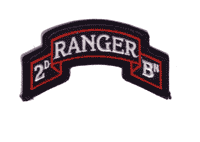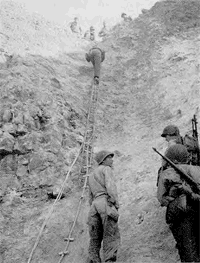2nd Battalion
 Active from 1 April, 1943 to 23 Oct, 1945
Active from 1 April, 1943 to 23 Oct, 1945
(per Ranger Memorial Fort Benning, GA)
The 2nd Ranger Battalion was activated on April 1, 1943 at Camp Forrest, Tullahoma, Tennessee. Shortly thereafter, then Major James E. Rudder, took command. Notices were sent to many military camps for volunteers from all branches of the Army for the formation of the new Ranger Battalion, the first to be trained in the United States. Qualifications for acceptance required strong physical capabilities and high intelligence. The selected best of the many volunteers became the 2nd Ranger Battalion and were to be trained and made ready for the invasion on D-day of the European Continent. The training was first provided by experienced combat-proven officers and NCOs who were assigned from the 1st Ranger Battalion commanded by Col. William O. Darby. The Rangers had to have the highest physical stamina and superior mental ability to perform as an outstanding fighting team in order to accomplish any given mission. They were skillfully trained and were proficient in all types of weapons, hand-to-hand combat, infantry tactics and many other skills necessary to be successful in war. In September 1943, the battalion moved to Fort Pierce, Florida. They received intensive amphibious training at the U.S. Navy Scouts and Raiders School. Later they moved to Camp Richey, the Army Intelligence School in using German weapons and German language.
Early in December 1943, the Rangers arrived in Grenach, Scotland. They were soon to learn about the vigorous training and fighting techniques of the Scottish and British Commandos. Christmas was spent in Bude, Cornwall on the western coast of England. Bude furnished the steep cliffs for training.
The battalion consisted of approximately 500 men. There were six line companies, "A" Company through "F" Company and a Battalion Headquarters Company. The line companies had two platoons. Each platoon had two rifle sections, a B.A.R. machine gun and a mortar section. There were 65 men plus 3 officers in each company. In January 1944, they were taught by the Commandos the use of small water-craft for night landings and associated combat and reconnaissance techniques. In the spring of 1944, the battalion was moved to an army assault training center at Braunton, England. In May 1944, the battalion participated in a full-scale pre-invasion exercise on the English coast called Fabius-7. The same month the provisional Ranger group (force) was placed under the command of Lt. Col. James E. Rudder and consisted of the 2nd and 5th Ranger Battalions who were destined to carry out the mission at Pointe Du Hoc and Omaha (Dog Green) Beach on the west coast of Normandy, France. H-Hour was 6:30 a.m. on the morning of June 6, 1944 (D-day). Companies D, E, and F due to navigation error, landed at 7:10 a.m. on Pointe du Hoc, but nevertheless, successfully completed its mission of scaling the 100-foot cliffs by the use of grappling hooks and ropes and destroying five 155 coastal guns by 8:30 a.m. The guns were found in their alternate positions about a mile from where they were supposed to be as previously indicated by Army Intelligence.
Company C landed at H-Hour on Omaha Beach. Their mission was to clear the enemy from the top of Pointe du La Percee to prevent the enemy from placing enfilading fire on Omaha Beach where the 1st and 29th Infantry Divisions were to also land. At 6:30 a.m. on June 6, Company C arrived on English landing crafts amidst intense fire. Almost half their men were killed crossing the beach under horrific heavy fire. Using their fighting knives and bayonets, three men scaled the 100 foot cliffs and dropped the toggle ropes to their remaining Rangers below to enable them to more easily climb the cliffs and successfully put out of action this very important and deadly German defensive position.

In September 1944 the Rangers were attached to the 8th Infantry Division to assist in clearing out the German resistance on the Crozon Peninsula. After accomplishing other objectives and rescuing 400 American prisoners, the battalion left for Landerneau, France. Later, they moved to Arlon, Belgium by "40 and 8's" via the railroad. arriving there on October 3rd. Shortly thereafter, they moved to Esch Luxembourg and were attached to the 1st Army. They later went to Vossenach, Germany and held the defensive line there and went on innumerable combat and reconnaissance patrols. On November 19th they were moved back to bivouac area in the Huertgen Forest, the whole battalion was alerted on the night of December 6th and moved out during that cold and wintry night to the Brandenberg area in Germany. The Rangers had been called to assault the icy, slippery Hill 400 which was approximately 403 meters (1,322 feet) high and steep, laden with many pill boxes and had the highest OP in the Roer Valley for miles around. The Rangers were told to hold their hill for 24 hours or until duly relieved. A patrol from "D" and "F" Companies at 3:00 a.m. was sent to reconnoiter the best plan of attack on the hill as dawn came up. "A", "B", "C", and "E" Companies got into position to secure the town of Bergstein, Germany where Hill 400 was located. December 7th Companies D and F launched an assault on Hill 400 at 7:30 a.m. It was a bloody battle with heavy casualties, but very successful. The Germans repeatedly counter attacked. The various attacks were horrendous with so many heavy artillery barrages and the many resulting tree bursts preceding each counter attack. The hill was held until relieved on or about December 9, 1944.
Maj. George S. William took over the command of the battalion on December 7th. Lt. Col. Rudder took over command of the 109th Regiment of the 28th Infantry Division the same day. The survivors of Hill 400 returned to the bivouac area in the Heurtgen Forest. The "rest" time did not last long as the remnants of the battalion were alerted to move up to defensive positions in Simmerath and were attached to the 78th Infantry Division who were to defend the left flank of the "Battle of the Bulge" as the German offensive became known, which commenced December 16, 1944. Christmas and the New Year came and passed without relief or replacements. Fortunately, the "Battle of the Bulge" was quickly being contained and driven back by the Allies. By mid January, Ranger replacements arrived and training began again by veteran Rangers amidst snow and below-freezing temperatures. Early in February, the battalion was put on alert and kept ready to cross the Roer River. They were then attached to the 102nd Cavalry forming two task forces. In this drive, the Rangers captured two dozen towns and approximately 500 prisoners. In mid March, time was used for reorganization and equipment cleaning and preparing for the next combat assignment. Near the end of March 1945, the battalion crossed the Rhine and was pressed back into more combat. Reconnaissance and combat patrols were operating continuously. Some Rangers took part in freeing many allied prisoners. On April 1, 1945 the Rangers celebrated their 2nd Anniversary (April 43-45).
Firefights and skirmishes were few and far between at this point in time and the men engaged in the mop-up of German resistance operations. More attention was now paid to snipers and saboteurs hiding behind the enemy lines, including the killing and capturing of many German soldiers. The first week of May 1945, the battalion was suddenly moved to Czechoslovakia, where further skirmishes were encountered and neutralized. Headquarters Company, who served the battalion gallantly and effectively, started its reorganization, replacing and repairing equipment, overhauling vehicles, providing needed medical care through battalion medics and bringing service records up to date.
Let the record of the 2nd Ranger Battalion stand as a memorial to those many Rangers who made the supreme sacrifice. Some veterans remained in the service to train other men for conflicts in Korea and Vietnam and subsequent confrontations. Other Ranger veterans in civilian life organized and formed the Ranger Battalions Association of WWII, which consists of Ranger veterans of the six Ranger Battalions of WWII. The RBA has kept the friendship and brotherhood of Rangers alive and well over these past 55 years and proven that "Ranger friendships are forever."
RANGERS LEAD THE WAY-ALL THE WAY
- Contributed by Henry A. Zyrkowski
"D" Company, 2nd Ranger Battalion

(US Army Photo Public Domain)
"Never has any commander been given a more desperate mission."
- General Bradley
"In a nation at war, teamwork by the whole people is necessary for victory. But the issue is decided on the battlefield, toward which all national effort leads. The country's fate lies in the hands of its soldier citizens; in the clash of battle is found the final test of plans, training, equipment, and-above all-the fighting spirit of units and individuals."
- Dwight D. Eisenhower
Recommended Ranger Links
- The Camp Shanks Memorial
- Pointe du Hoc - 2nd Ranger Battalion
- D-day Museum, United Kingdom
- Research Reading List
- Rangers in World War II (An excellent comprehensive account of all six Battalions by Ranger Robert W. Black)
 DESCENDANTS OF WWII RANGERS, INC
DESCENDANTS OF WWII RANGERS, INC 